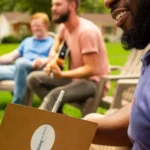Hallucinogens refer to a diverse group of drugs that alter a person’s perception of the world as and their thoughts and emotions. A sub-category is dissociative drugs, that cause feelings of being disconnected from one’s body and world around them. Both types cause the person using the substance to hallucinate, or see, hear, smell or feel things that are not really there [1]. Some hallucinogens occur naturally in the form of certain mushrooms and plants, and others are synthetic (man-made). The substances under the hallucinogen category have been used in religious and cultural ceremonies, as well as medical research in the past. Effects begin within 20 minutes, and can last from 90 minutes to 12 hours, depending on the substance and dosage. Experiences while using hallucinogens are referred to typically as “trips”, and if the effects are negative, unpleasant, or scary, it is called a “bad trip”.
Researchers are still working to understand exactly how these drugs work in the body, but the commonly believed theory is that the drugs cause interruptions in the communication between the brain and nerves in the spinal cord and throughout the body, creating drastic changes in the body’s ability to regulate mood, temperature, and other functions [2].
The most commonly known hallucinogen is LSD or “acid”. It is generally the strongest of the classic hallucinogen category and is a clear or white material found in a certain type of fungus that grows on rye and other grains. It is usually administered through “blotters”, or soaked into paper that is dissolved on the tongue.
Psilocybin and peyote are plants that produce hallucinogenic effects when ingested. Psilocybin is a mushroom, commonly called “magic mushrooms” or “shrooms”. Peyote is a cactus that contains the hallucinogen mescalin, and is commonly called “buttons” or “mesc”.
DMT is the natural or synthesized form of chemicals found in a certain type of plant found in the Amazon. In its plant form, a tea is made of the parts of the plant that contain the chemical and ingested. The lab-made form is a white powder that is smoked.
There are also several dissociative types of hallucinogens, including PCP, Ketamine, DXM and Salvia. PCP, or “angel dust” or “embalming fluid”, is a commonly used veterinary anesthetic that was used at one time for humans, but caused severe side effects. It is found in many forms, but liquid and powder forms are used most frequently via smoking. Ketamine is another anesthetic used today, in both humans and animals. It is most often used in powder or pill form, but it can be injected as well. Street names are “Special K” and “Cat Valium”.
Dextromethorphan, or DXM, is an ingredient found in over-the-counter cough medicines. The liquid or pill forms are ingested in large quantities to produce a dissociative, hypnotic effect. DXM is also referred to as “Robo”.
Salvia is a plant that grows naturally in tropical and subtropical climates. The intoxicating chemicals are ingested by chewing on the leaves or smoking the dried leaves. Other names include “Magic mint”, “Diviner’s sage” or “Sally-D”
Signs of Hallucinogen Abuse
The short-term effects of hallucinogens vary slightly, but both dissociative and “classic” types produce vivid images and sensations that are not actually there. An increase in heart rate and blood pressure is common as well, and feelings of paranoia or fear. Changes in body temperature (generally increased) are also typical for many of the drugs above. The perception of time passing is distorted, and the 5 senses can become “confused”, causing mixed sensations such as “seeing music” or “hearing colors”. Motor function is also affected, and loss of body coordination is commonly observed. Physical tolerance builds quickly, with an increased need for more of the substance to create the same “high”.
Abuse of a substance is indicated whenever it begins to impact their day to day lives. Financial troubles from spending large amounts on substances, job loss or impairment at work, social isolation, and relationship problems are all indicators that use is problematic. Any use of a substance that produces struggles to control or stop use and have negative consequences, as a result, can be considered problematic. Additionally, the use of hallucinogens frequently causes self-harming behavior due to distorted perceptions while under the influence, presenting a physical danger to the person using the substance.
Withdrawal and Detox
Long-term, tolerance is built rapidly in LSD use, causing the need for more of the substance to gain the same level of effect. Although physical withdrawal symptoms do not tend to occur, a serious condition called hallucinogen persisting perception disorder (HPPD)[3], also called flashbacks. Persistent psychosis, or a state of prolonged mental disorganization, visual disturbances, and mood instability, occurs without warning and in as little as one use.
PCP and DXM both produce cravings, headaches, and unpleasant withdrawal symptoms if stopped suddenly. Regardless of the substance, the assistance of a professional to monitor and offer help throughout the process is important.
Addiction Treatment and Rehab
The decision to seek help is the first step in the process of recovery. Medical evaluation and detox are usually the first several days of the client’s stay, to ensure that uncomfortable or unpleasant symptoms are under the care of a physician.
After an initial stay in detox, the client is moved to residential treatment. Here they are offered a variety of evidence-based treatments in a trauma-informed, experiential format to provide hands-on education and exploration of the underlying factors contributing to continued use. Focusing on mind, body, and spiritual wellness, our team of trained therapists, physicians, and client support staff work with the client to discover and develop a plan that works specifically for them throughout the treatment process and beyond.
Aftercare
While in residential treatment, the client and treatment team begin to form a relapse prevention plan and choose if IOP (intensive outpatient treatment) or outpatient care is appropriate, and set up appointments with providers wherever possible. Education for family members and support systems are important as well. Continued connection with others in recovery through recovery groups or 12-step meetings, supportive family and friends, and continued therapeutic care help strengthen the client’s “recovery toolkit” and increase the likelihood of a successful long- term recovery.
Resources
[1] NIDA, https://www.drugabuse.gov/publications/drugfacts/hallucinogens
[2] NIDA, https://www.drugabuse.gov/publications/research-reports/hallucinogens-dissociative-drugs/what-are-hallucinogens
[3] NIDA, https://www.drugabuse.gov/publications/hallucinogens-dissociative-drugs/how-do-hallucinogens-lsd-psilocybin-peyote-dmt-ayahuasca-affect-brain-body



















